Flagship Programs
Following the new conceptual framework outlined here, these Research Highlights are identified as contributing to understanding Earth Architecture (the roadmap for fluids) and/or Fluid Fluxes (the “traffic report”), with logos for easy attribution.


1. DEEP-EARTH FLUIDS IN COLLISION ZONES AND CRATONIC ROOTS (TARDIS II)
Themes 1, 2 and 3, Early Earth, Earth's Evolution and Earth Today, contributing to understanding Earth's Architecture and Fluid Fluxes.
AIMS
This program investigates the role of fluids in the deep mantle and lithosphere, using studies of kimberlites and other volcanic rocks, xenoliths of mantle and crustal rocks in volcanic rocks, ophiolites, and UHP terrains related to subduction zones. Super-reducing, ultra-high-pressure (SuR-UHP: 400-600 km) mineral assemblages in some ophiolites carry implications for the evolution of fluid compositions, reactions and redox states in subduction environments from the surface to the Transition Zone, and suggest a new geodynamic collision process that may improve mineral exploration concepts for paleosubduction regimes. The recent discovery of similar ultra-reduced mineral assemblages in ejecta from Cretaceous volcanoes in Israel suggests a previously unrecognised process of interaction between highly reducing deep-mantle fluids and ascending basaltic magmas. We aim to produce an experimentally testable model for the generation of such fluid conditions in the mantle, to quantify constraints on the geochemical and tectonic processes that have produced SuR-UHP assemblages, and to produce a geodynamic model for these processes.
2020 REPORT
The TARDIS project team continued in 2020 to carry out research on significant questions including those relating to kimberlite genesis, the petrogenesis of super-reduced magmatic systems, the evolution of the North China Craton, magmatism and tectonics in the Tethyan collisional belt, and the mantle beneath the Pannonian Basin in Hungary.Kimberlites
Montgarri Castillo-Oliver, Andre Giuliani and coworkers completed a longitudinal study of carbon isotopes in kimberlites worldwide (CCFS publication #1421), concluding that a major Early Phanerozoic shift to isotopically lighter carbon reflects the beginning of subduction of organic carbon into the deep Earth. The topic is controversial and the paper is still out to review at the time of this report.
We were part of a large group collaborating with PhD student M. Kilgore (#1515) who measured the hydrogen contents in xenoliths from the Lac de Gras kimberlites of N Canada and linked the variations to the metasomatic profile previously established by GEMOC/CCFS research. Further information on the metasomatic fluids was provided by Zedgenizov et al. (#1536) who analysed the composition of diamond-forming high-density fluids in the Siberian SCLM.
Xenoliths from kimberlites and the Deccan Traps in the Dharwar Craton of India, integrated with geophysical data, documented (#1548) the strong effect of the Traps magmatism on the composition and stability of the western part of the Dharwar cratonic root.
In related work, Perchuk et al. published a paper in Nature (#1531) that used dynamic modelling to develop a new model for the generation of the cratonic keels in early Archean time. This model was inspired and validated by comparison with the 4D Lithosphere Mapping profiles of SCLM stratigraphy built up by GEMOC/CCFS research over 20 years.
Ultra-reduced magmatic assemblages, Mt Carmel, Israel
Significant progress was made in this subproject this year. Oliviera et al. (#1533) used numerical modelling of zoning profiles in Carmel Sapphire aggregates to show the growth of skeletal corundum in an initially open system. The calculations showed that the entire mineral system represented in these aggregates evolved over a period of days to weeks, probably in conduits filled with rapidly moving melts and volatiles.
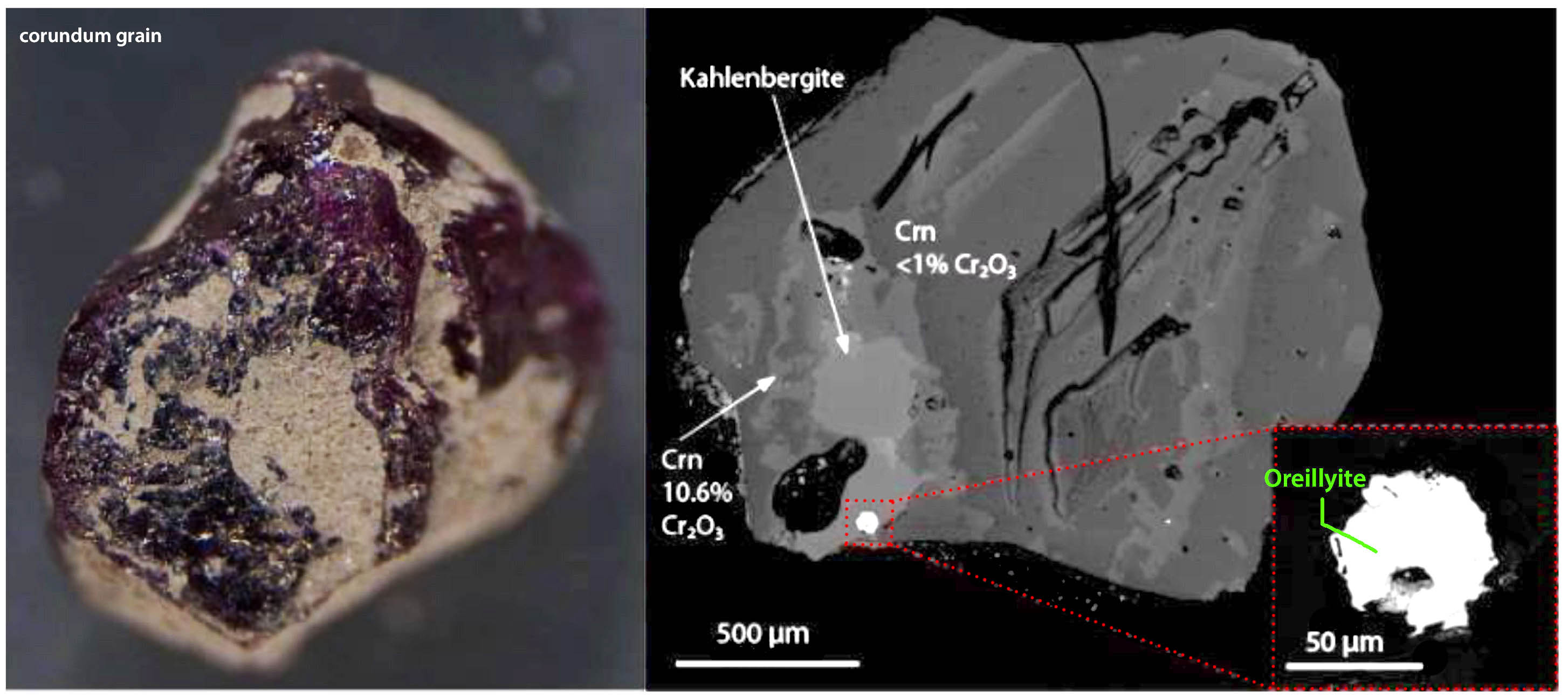
Oreillyite was discovered in a corundum grain (left) within a sample of volcanic ejecta from Mount Carmel in Northern Israel. RIght; Scanning electron microscope (SEM) image showing the Oreillyite inclusion ( Bindi et al. 2020).
Two new minerals, kishonite (VH2) and oreillyite (Cr2N) (see https://www.auscope.org.au/news-features/oreillyite) were described (#1542), the latter named after Suzanne O’Reilly, director of CCFS (see figure). Another paper (#1427) established the siderophile behaviour of boron under reducing conditions, while a third documented the evidence for solar-nebula oxygen fugacities in V0-bearing xenoliths.
Huang et al. (#1492) described the mineral inclusions in SiC (moissanite) from Mt Carmel and Siberian kimberlites, establishing that most SiC in such occurrences forms from immiscible metallic melts at high temperature and very low oxygen fugacity. Two other papers in American Mineralogist documented the behaviour of chromium in reducing conditions and Al-rich melts (#1532), and the occurrence and genesis of the immiscible metallic melts in the Mt Carmel material (in press 3/21). The two remaining papers in this project are in preparation, and some further analytical work was carried out in 2020 despite the pandemic.
North China Craton (NCC)
Work in 2020 focused on the evolution and nature of the lower crust beneath the craton and adjacent areas. Hongkun Dai continued his work on basalts and xenoliths from the Langshan area on the northern edge of the NCC, publishing a major paper in Journal of Petrology (#1633), while three more papers (including an invited paper in Earth Science Reviews (#1561) from this project are in press in major journals). Wang et al. (#1642) documented the presence of Eoarchean crust in the adjacent Central Asian Orogenic Belt, a major Proterozoic orogen.
Pannonian Basin
The Nógrád-Gömör Volcanic Field (NGVF), in the northern Pannonian Basin in Central Europe is one of five key localities where the lithospheric mantle of the Carpathian-Pannonian region can be studied using peridotite xenoliths hosted in late Miocene to Pleistocene alkali basalts. Liptai et al. built on a major study (#1361) that documented the regional distribution of microstructural characteristics in the xenoliths. Using a combination of FIB-SEM sequential sequencing and LA-ICPMS they have analysed silicate melt inclusions in the minerals of spinel peridotite xenoliths, providing new insights into the nature of the metasomatising agent that has modified the composition of the xenoliths. The paper is in press in American Mineralogist (#1530).
Tethyan Belt and other collisional orogens
Work in 2020 focused on the evolution of the petrological and tectonic evolution of the continental crust of northern Gondwana, now found in accretionary terranes in both Iran and Tibet.
Hadi Moghadam extended his long series of publications on the crustal and tectonic evolution of the Tethyan Belt in Iran (#1504, 1505, 1513, 1544). Sarshar et al. (#1513) investigated the hidden Cadomian crust in SE Zagros using exotic blocks entrained in salt diapirs. Esmaeili et al. (#1419) used amphibolites in the Makran accretionary complex to unravel permo-Triassic Neo-Tethyan evolution.
Two papers on the origin and role of pyroxenites in subduction wedges used material from W Victoria (#1387) and NW Spain (#1410).
Bo Xu and coworkers completed a series of four papers dealing with the nature and distribution of volatile phases in Cu-Au porphyry deposits in southern Tibet, and the broader controls of crustal and mantle architecture in this region. Two have been published (#1485, 1541), and two are under review. Xiong et al. 1386) investigated the effects of sulfides in Tibetan ophiolites on the stability of the Re-Os system, with implications for the interpretation of Re-Os ages (see also #1512).
WORKPLAN 2021
Work will continue on each of the projects addressed above. Most of the work in the Kimberlites and related rocks, the Ultra-reduced magmatic assemblages, Mt Carmel, Israel and the North China Craton will be focused on finalising these projects to the stage envisaged and forecast by the end of 2021. This will include writing up the remaining results and concepts for publication in high-ranked journals.
Tethyan Belt: Work will continue on the magmatic and structural evolution of the Tethyan Belt in Iran, continuing a very successful synthesis of the development of the northern edge of Gondwana, the detachment of a series of microcontinents, and their amalgamation to the European continent. Work in Tibet will start a new strand focussing on understanding the origin of previously collected samples in the Kangjinla region and implications for the tectonic history. This is in collaboration with CCFS PhD student Hongkun Dai and other colleagues from the School of Earth Sciences, China University of Geosciences, Wuhan (China)
A new phase of the TARDIS Project will commence in 2021. One of the new directions is funded by ARC DP grant DP210102196, titled “The link between cratonic roots, redox state, and mantle geodynamic.” This project aims to understand the role of Earth‘s redox state on the geodynamic evolution of continental cratonic roots. Cratonic roots form strong, buoyant rafts upon which Australia‘s oldest crust and mineral deposits survived. Cratons preserve a record of planetary-scale chemical shifts, including the rise of surface oxygen, but it is unclear how these redox shifts themselves affected lithospheric processes. This project integrates new developments in geochemistry, geophysics, and geodynamics, to map the geochemical state and structure of cratonic roots, aiding mineral exploration, and also shedding light on the processes that modify, mineralise, and sometimes destroy cratonic roots.
A consortium of CCFS researchers, with international and industry partners, has applied for an Australian Government Australia-China Science and Research Fund Joint Research Centre titled “Deep Exploration for Critical Minerals: Accelerating a Sustainable Future”.
The scheme outcome was to be announced in February 2021 but has been delayed. If successful, this project will commence in 2021, springboarding from CCFS new findings to result in making the deep Earth beneath Australia and China transparent. Geophysical arrays will be deployed regionally, coinciding with geochemical mapping using new analytical technologies. Unparalleled rich datasets characterising the hidden uppermost 300 km of the Earth that controls formation and location of ore deposits will reveal in 4 dimensions (deep space and time), Earth structures and processes not previously accessible. This new knowledge will enrich our understanding of Earth’s 4.6 billion year evolution, and directly benefit mineral exploration targeting. Continuing support from Minerals Targeting International will fund a new aspect of the ongoing GLAM (Global LIihospheric Architecture Mapping) project “Archean mantle and plate tectonics: the seismic record of arc magmatism”.
In collaboration with colleagues from the University of Sydney, CCFS researchers have sought ARC DP funding for 2022 for a project titled “Mapping mineral systems of deep Australia” aimed at enabling mineral resource discoveries by calibrating geophysical surveys using geochemical and petrophysical properties measured on mantle samples brought to the surface by recent volcanoes. National geophysical surveys deliver images of geophysical gradients in the deeper part of the Australian continent. The interpretation of these gradients in geological terms and in terms of economic mineral systems is the key to unlock deep exploration success. This project will turn Australia’s investment in National geophysical surveys into new discoveries of base metals. The benefit stems from enabling the transition to a clean economy which requires a much broader range of critical minerals and a larger quantity of base metals.
Published outputs for 2020
CCFS publications: #1381, 1383, 1386, 1387, 1410, 1419, 1421, 1423, 1427, 1485, 1488, 1489, 1492, 1499, 1502, 1503, 1504, 1505, 1506, 1512, 1513, 1515, 1521, 1525, 1530, 1531, 1532, 1533, 1536, 1541, 1542, 1544, 1558, 1561, 1633, 1642

2. GENESIS, TRANSFER AND FOCUS OF FLUIDS AND METALS
Themes 2 and 3, Earth’s Evolution and Earth Today, contributing to understanding Earth’s Fluid Fluxes.
AIMS
This program embodies a holistic approach to ore deposit research, acknowledging that the genesis of mineral occurrences requires the conjunction in time and space of three main independent parameters: fertility, lithosphere-scale architecture, and favourable transient geodynamics. In this context, the integrated studies in this Flagship program address the critical link between metal source fertility and four-dimensional evolution of multi-scale fluid pathways that ensure efficient mass and fluid flux transfer between the mantle and the upper crust. Our studies test the hypothesis that the genesis of sizeable mineral deposits is the end product of self-organised critical systems operating from the scale of the planet all the way to the very focused environments where ore deposits can form. This Flagship Program is not commodity-focused but rather looks at the basic commonalities among various mineral systems to unravel the main constraints in the formation of ore systems.2020 REPORT
In 2020, despite the disruptions related to the COVID pandemic, this Flagship Project progressed well, generating world-class results published in prestigious journals, attracting media attention, and seeding foundations for future strategic partnerships with industry. Work mainly focused on establishing the cycle of volatiles and metals at the scale of the lithosphere: Dr Eunjoo Choi received her PhD in early 2020, documenting Proterozoic magmatism in the Yilgarn Craton as a probe to unravel the first-order control on its metallogenic fertility and endowment. Mr Jason Bennett, Mr Greg Poole and Constanza Jara submitted their PhD studies and are expected to defend in mid-2021. Past and ongoing projects have significantly contributed to and engaged industry and generated new projects on various mineral systems in collaboration with industry:
- • ARC LP190100785 “Experimental Constraints on the Genesis of Gold-rich Ore Deposits”. The project, in collaboration with AngloGold Ashanti, Newmont, Anglo American and Rio Tinto will provide a new set of tools to explore for gold-rich ore deposits in Australia and globally. By integrating geochemical studies with cutting-edge experiments carried out at three Australian universities in strategic partnership with industry, the outcomes of this project will provide much needed knowledge to predict the locations of large gold-rich deposits that are concealed beneath vast expanses of the Australian continent. The new results will translate into smarter exploration practice, significantly enhancing success in targeting ore deposits that are rich in high-value metal and display the smallest have a small environmental footprint, to underpin the sustainability of our nation into the future. The project involves PhD student Carolina Mafra based at UWA.
- • The High Grade Hypogene Porphyry (HGHP) project is funded by BHP as a collection of research initiatives (spread between separate institutions including UWA) designed to investigate the primary geologic controls on enhanced grade porphyry mineralisation. It is designed to identify new genetic and economic parameters for giant high grade hypogene systems in order to develop detection tools that can be employed at all scales of observation and at all stages of the exploration process. In order to achieve this, an ‘all of mineral system’ approach has been identified as a key overarching principle. The project, as a whole, aims to establish the combination of mineral system elements that contribute to known high grade hypogene systems.
- • In addition, in collaboration with IGO, work has focused on the characterisation of the geochemical and isotopic signature of mafic and ultramafic rocks in the Proterozoic Albany-Fraser Belt, Yilgarn Craton, Western Australia. In 2020, the work mainly aimed at unravelling the significance of garnet as a potential resistate mineral indicator. Further work in 2021 will also involve PhD student Joshua Chong, who will focus on the role of carbon as a catalyst for metal transport across the lithosphere.
- • A new project at Boddington involving PhD student Nathan Bowman commenced in 2020, with significant funding and logistical support from Newmont. The project aims at unravelling the geochronological and geodynamic constraints on the genesis of one of the largest and most poorly understood Archean gold systems.
- • A new project with BlueJay mining pls on Disko Island (Greenland) and Impact Minerals Ltd in western New South Wales (Australia) also started in 2020. The project involves PhD student Maria Cherdantseva, who investigates the role of volatiles in the transport of magmatic sulfides across the lithosphere.
- • In 2020, the MRIWA Yilgarn2020 project made significant progress, with PhD student Anne Virnes leading the way in the study of multiple sulfur isotope systematics applied to komatiite systems.
In 2020, overseas fieldwork activities had to stop for logistical reasons. However, fieldwork related to the research activities of this Flagship Project continued in Australia, with work focused in New South Wales and Western Australia, mainly along the Fraser Belt and the Agnew-Wiluna Belt. The goal is to gradually re-start fieldwork activities globally in late 2021 and from 2022 onwards.

Fieldwork in Western Australia was the focus of activities given the inability to travel overseas.
WORKPLAN 2021
Work in 2021 will be carried out within the framework of a number of ongoing PhD projects, mainly funded by ARC or industry, and the work of ECRs at UWA. The main focus will be sampling and analysis for the key industry-funded projects that started in 2020. Strategic partnerships with overseas institutions will be strengthened, with the potential to engage Master students in other countries who could carry out sampling at specific locations. An example is the involvement of Masters students from the University of Bologna (Italy), who will be working in the framework of ARC LP190100785. A new strategic project on the role of carbon in the transport of metals in collaboration with the University of Leicester is currently being designed to be discussed with interested companies in mid-2021. This project would build on the results from CCFS Flagship Program 2 over the past decade and embody the legacy of significant research excellence that was generated.
Published outputs for 2020
CCFS publications: #1175, 1384, 1408, 1409, 1431, 1487, 1508, 1516, 1520, 1551, 1552, 1648 .

3. MODELLING FLUID AND MELT FLOW IN MANTLE AND CRUST
Themes 2 and 3, Earth’s Evolution and Earth Today, contributing to understanding Earth’s Architecture and Fluid Fluxes.
AIMS
Many aspects of Earth Science, from ore deposits to giant earthquakes, depend critically on the complex interaction of solids and fluids. Numerical simulation of these processes and effective visualisations of the results is critical to understanding how these Earth system components work, but our ability to do this is currently very limited. Flagship Program 3 is developing the next generation of numerical codes and aims to refine the thermodynamic parameters involved by integrating high- pressure experiments to handle these complex problems. This will lead to important improvements in the quantification and visualisation of Earth processes, and will be applied to a variety of geodynamic situations.
The new high-pressure experimental group at Macquarie joins this initiative to provide input on physico-chemical parameters of minerals, melts and fluids in the deep mantle, the composition of melts that infiltrate the lithosphere, and their effects on its geodynamics and stability.
2020 REPORT
The major outcomes from this program have been the development and expansion of Litmod and its subsidiary codes, the completion of the first 3D probabilistic inversion method for MT data and the development of a new multi-phase multi-component reactive formalisms to handle complex physiochemical processes. science outcomes from these developments in the past year includei) The first fully probabilistic method to invert stand-alone 3D MT data and joint seismic+MT data for the thermochemical structure of the lithosphere, presented in Manassero et al. 2020 (CCFS publication #1653).
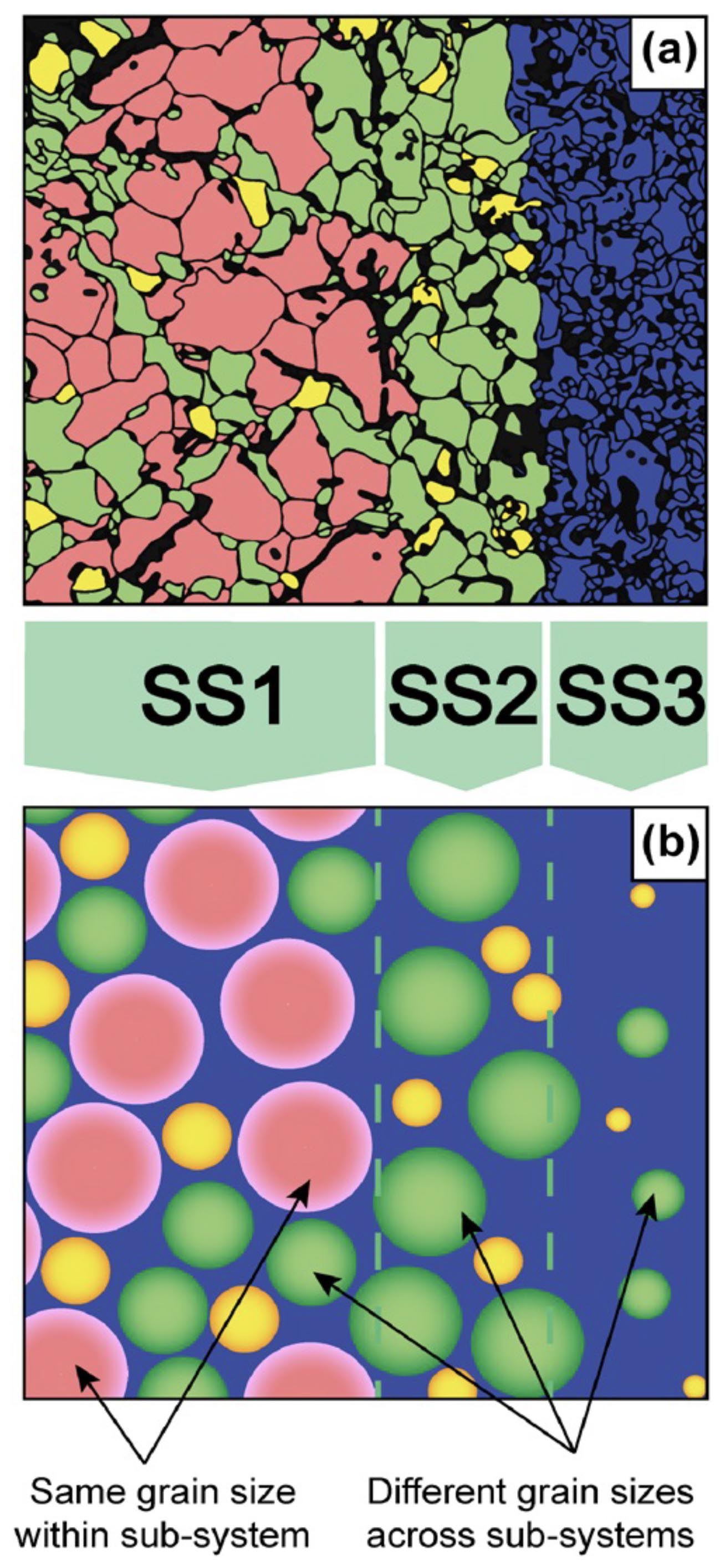
Figure 1. Schematic illustration of the diffusional re-equilibration model. (a) Mineral grains within a representative volume (spatially rearranged for convenience). (b) Individual grains are approximated as spheres. If there is melt present in the subsystem, the grains are assumed to be fully embedded in melt and keep the spherical shape. Different types of mineral grains will in general have different grain sizes that will evolve according to P-T-cb conditions (e.g. Ol, Cpx, Opx). Same type of minerals within each subsystem (e.g. every Ol grain within ss1) is modelled with a uniform grain size; however, different grain-size models are allowed across subsystems (e.g. Ol gains in ss1 and ss2 evolve according to different models). (From Oliveira et al 2020 Journal of Petrology, https://doi.org/10.1093/petrology/egaa067.)
ii) The development of a platform for modelling multi-phase multi-component reactive transport and its application to elucidating chemical-energy-mechanical feedbacks during magmatism. A new paper by Bravo et al. (CCFS publication #1510) presents a conceptual and numerical model to study the dynamics and nonlinear feedbacks inherent in mantle magmatism and to make quantitative comparisons between petrological and geochemical datasets (fig. 1).
iii) Improved seismic models of the structure of the Chinese and Spanish lithospheres. Results were published in Zhang et al. (#1655) and Fullea et al. (#1656)
iv) First application of the litmod approach to the Australian lithosphere for large-scale exploration purposes. Results were published in Haynes et al. (#1654)
v) The development of ultra-fast 3D Stokes solvers for probabilistic inversion approaches for dynamic topography and mantle flow. Results were published in Galabert et al. (#1652) The high-pressure experimental laboratory is in full swing under the auspices of Laboratory manager Slava Shcheka, with three post-doctoral researchers and several HDR students conducting experiments as part of their thesis studies. Many of the projects have looked at interactions between melts of crustal rocks when they react with mantle peridotites, whereas others are investigating melt compositions produced from mantle rocks. The sedimentary materials included in the experiments concentrate on likely major contributors to material in subduction zones. Michael Förster has been looking at reactions with marine sediments, whereas Chunfei Chen is investigating the behaviour of carbonates. Researchers have tended to use average compositions of sediments in their experiments, which include just small proportions of carbonates (<10%). Chunfei’s investigations make the point that most carbonates are subducted as thick packages of nearly pure chalk or limestones, whose melting properties are poorly known.
Several HDR students successfully completed their theses this year: Zsanett Pintér investigated melt compositions produced from mantle peridotite that contains CO2 and H2O mixtures, whereas Zairong Liu investigated melting with CH4-H2O mixtures corresponding to more reduced conditions at low mantle pressures of around 2 GPa. Chengyuan Wang is producing multiple publications from his study of the lithospheric evolution of the Trans-North China orogen, and Mingdi Gao has completed his work on interactions in collision zones.
WORKPLAN 2021
Work will continue in 2021 towards developing the next generation of tools for Earth Science simulations - in particular, novel techniques to model the interaction of fluid flow with solid geodynamic process from the crust to lithosphere,and deeper mantle.
The Australian Laureate project “Deep Earth Cycles of Carbon, Water and Nitrogen” continues into its third year. Current experimental projects include reaction experiments between crustal rocks and mantle in subduction zones (Chutian Shu, Chunfei Chen), the extension of partial melting experiments on peridotites with CO2 and H2O (Isra Ezad), investigations of the role of grain size on melt mobility (Michael Förster and Juan Carlos Afonso), melting of sulphur-bearing pyroxenites as possible sources of Cu-porphyries and shoshonites (Anthony Lanati), halogen partitioning between hydrous minerals and melts (Isra Ezad and Matthew Phillips), and the partitioning of nitrogen between hydrous minerals, fluids and melts (Michael Förster). Chutian is also investigating melting of hydrous pyroxenites in the mantle wedge above subducting plates and assessing which melts could be produced from them.
Published outputs for 2020
CCFS publications: #1363, 1379, 1385, 1395, 1393, 1394, 1408, 1410, 1417, 1420, 1488, 1510, 1552, 1553, 1554, 1557, 1560, 1562, 1564, 1615, 1616, 1617, 1648, 1644, 1625, 1653, 1654, 1655, 1656.

4. ATMOSPHERIC, ENVIRONMENTAL AND BIOLOGICAL EVOLUTION
Theme 1 Early Earth, contributing to understanding Earth’s Architecture and Fluid Fluxes.AIMS
We investigate how the evolution of life and ore deposits were linked to the changing whole-Earth system, focusing on planetary driving forces that affected all the different shells of the planet, to develop a 4-dimensional conceptual framework of Earth evolution. Given the broadly comparable petrological evolution of Earth and Mars, we also aim to put forward new working hypotheses on how life and mineral systems may have formed and evolved on the red planet and are involved in NASA’s Mars2020 landing site selection process. This program tests the hypothesis that the evolution of life and the genesis of sizeable mineral deposits are the end products of systems operating at the scale of the planet all the way down to the specific environments where life flourished and mineral deposits formed. A component of the program focuses on Mars to investigate whether the evolution of life and the genesis of mineral systems on the red planet operated in a broadly similar fashion. We evaluate the relative importance of: (1) the threshold barriers that form in specific environments, creating strong chemical and energy gradients in the crust, and the self-organised behaviour of mineral systems and life; (2) the evolving nature of ’traps’ at the lithosphere-hydrosphere boundary, where life and ore deposits developed through time; (3) the global-scale cycles of key elements and heat transfer essential for the evolution of life and formation of ore deposits and 4) the 4-D evolution of the pathways that connect different geochemical reservoirs through time, linked to the changing tectonic style of the planet, as a guide to understanding biological and ore deposit evolution through time.2020 REPORT
In 2020, this Flagship Project continued its focus on identifying proof of biogenicity for the oldest evidence of life on Earth, as well as understanding more about the environments that it inhabited, as well as studying the rise of eukaryotes in rocks from Western Australia.Work mainly focused on two main areas in Western Australia: the 3.53-2.83 Ga Pilbara Craton and the c. 2.4 Ga Turee Creek Group of the Mount Bruce Supergroup, the succession that unconformably overlies the Pilbara basement.
In the Pilbara Craton, research continued to focus on the oldest, most convincing evidence of life on Earth as preserved in the 3.48 Ga North Pole Chert Member of the Dresser Formation, Warrawoona Group. Research conducted by Dr Raphael Baumgartner, a UNSW post-doctoral research fellow funded by the CSIRO in Perth, published three papers that help further prove the biogenicity of ancient stromatolite fossils from this unit. In his first paper, Baumgartner et al. (CCFS publication #1487) performed scanning electron microscopy, Raman spectroscopy, high resolution elemental mapping using Synchrotron Radiation X-ray Fluorescence Microscopy, and Laser ablation inductively coupled plasma mass spectrometry on samples of sulfidised stromatolites from fresh drillcore in order to define variations in geochemistry within stromatolite layering (Fig. 1). This study identified cyclical variations in arsenic, zinc, and nickel that point towards precipitation of metals by microbial activity, likely predominantly sulfate-reducing bacteria and/or anoxygenic photosynthesisers.
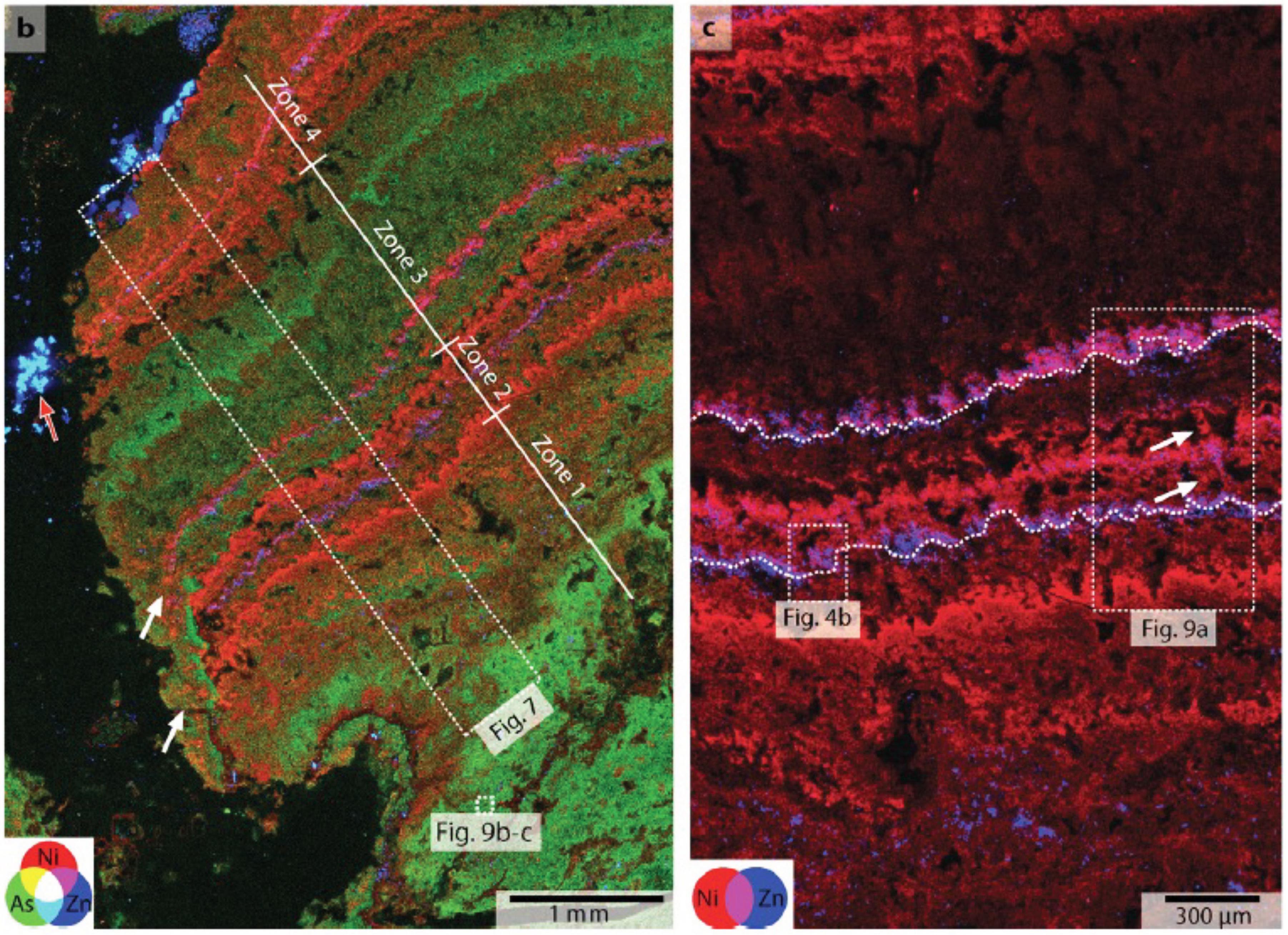
Figure 1. Elemental distribution maps of Dresser Formation stromatolites. B) Elemental distribution map of Ni, As and Zn, showing a laminated sulfide column within coarsely crystalline barite (black; compare with Fig. 2a). An overgrowth relationship within the internal fine-scale lamination of this sulfide column is indicated (white arrows). Note the dispersed sphalerite grains (red arrow) in adjacent barite, and the strong enrichments of As in the lower, more irregular and less laminated, part of this stromatolite column. C) Elemental map showing the distribution of Ni and Zn in the central part of the laminated sulfide column. Microdigitate enrichments of Ni (white arrows) and wrinkly laminations of Zn (white lines) are indicated. From Baumgartner et al. (#1487).
In his second paper, Baumgartner et al. (#1651) identified microspherulitic barite mineralisation within organic matter remnants trapped inside the sulfidised Dresser stromatolites (Fig. 2). These tiny (1 μm) microspheres of barite contrast dramatically with the coarse barite crystals that are so common throughout the North Pole Chert Member and derive from hydrothermal solutions. The microspherulitic barite is identical to that found in modern settings where microbial activity has induced crystallisation from the seawater, such that its presence in the ancient Dresser rocks is strong support for biological activity. In the third paper, Baumgartner et al. (#1431) investigate biogenicity through in situ sulfur isotope analysis of the various phases of pyrite within the sulfidised stromatolites identified in Baumgartner et al. (#1397). The δ34S shifts (up to ~17‰) generated by sulfate reduction are consistent with both thermochemical reactions and influence of sulfate-cycling microbes, the latter which may have facilitated rapid pyrite precipitation and preservation of microbial remains that are entombed within the petrogenetically earliest pyrite generation of stromatolites. Collectively, the data are consistent with ancient stromatolite growth in proximity to shallow marine hydrothermal vents, where hydrothermal fluids contributed to sulfidisation that may have been further influenced by sulfur-cycling microbes.
Further research was conducted on the Dresser Formation by both Dr Stefano Caruso, a UNSW post-doctoral fellow, and by Sahand Tadbiri, resulting from his MSc degree work at UNSW. Stefano conducted detailed geochemical and XRD research on the hydrothermal alteration assemblages that characterise the footwall of the Dresser Formation in metabasaltic rocks that host a dense network of black chert±barite±pyrite±chalcedony veins that represent the fossilised fluid conduits during cycling of warm to hot fluids through the crust. Previous work suggested that the distribution of varied mineral assemblages was zoned in a vertical manner beneath the dresser Formation, but Stefano’s research shows that the mineral assemblages are distributed around the major veins, which were the source for the heat and fluid that caused the alteration. This work is being written up for publication in 2021
Sahand’s project also looked at the hydrothermal veins, but from the viewpoint of their structural distribution and sequence of emplacement. Tadbiri and van Kranendonk (#1517) identified four main sets of hydrothermal veins that were emplaced during uplift and subsequent collapse of an active volcanic caldera that hosted the stromatolites of the North Pole Chert Member. The veins define a conjugate, to more complex, structural pattern around the North Pole Dome that fits very well with known examples of more recent calderas and with sandbox models of caldera formation. Veins were emplaced within radial and concentric faults and/or fractures associated with caldera formation, but ceased after the caldera collapse except within long-lived extensional growth faults.
Dresser research also featured prominently in a chapter for a Springer book entitled “Mars Enigmas”, which will be published in 2021 (Van Kranendonk et al., in press). This chapter summarises the environments where early life is found in the ancient Pilbara rocks (3.5-2.75 Ga) and includes nine distinct habitats, all of which can be used as analogues for where to search for life on Mars.
In addition, 2020 saw the publication of the second of three special issues of the journal Astrobiology (V. 20, No. 4) guest edited by Prof M. Van Kranendonk, on hot spring research. Specifically, these special issues focus on aspects of hot spring research that will aid in the search for life on Mars, and they include studies on everything from hot spring geochemistry, to geological facies of sinter deposits, to microbial communities and their fossilised remnants, and include authors from within the CCFS. One paper in the second issue by Teece et al. (2020) describes the discovery of preserved biomolecules from fossilised hot springs in New Zealand. Another by Ruff et al. (#1362) describes the case for siliceous sinter at Home Plate in Gusev Crater on Mars. Others develop the hot spring model for the origin of life, describe trace element enrichments in fossil microbes from hot spring sinter, outline the microbial origin of palisade fabric in sinter, and characterising the mineral assemblages of hot spring environments and how this applies to Mars orbital data.
The other main field of research is on the evolution and adaptation of life to the Great Oxidation event in a well preserved microbialite reef complex from the 2.4 Ga Turee Creek Group of Western Australia. Ms Georgia Soares (UNSW) submitted her PhD thesis on “An early attempt at complexity: branching siliceous structures in the 2.4 Ga Turee Creek Group”, which described novel macroscopic fossils that appear to have characteristics more in line with an eukaryotic lineage than a prokaryotic origin. These branching organic Structures are distinct from any previously documented form of microbialite and are characterised by siliceous core zones within an otherwise entirely carbonate environment. The results of this study augment previous discoveries of complex microfossils in the same unit by Barlow and van Kranendonk (#1340). Nomchong and Van Kranendonk (#1415) describe the oldest documented thrombolites on Earth from this same unit, again highlighting an early onset of complexity of life.
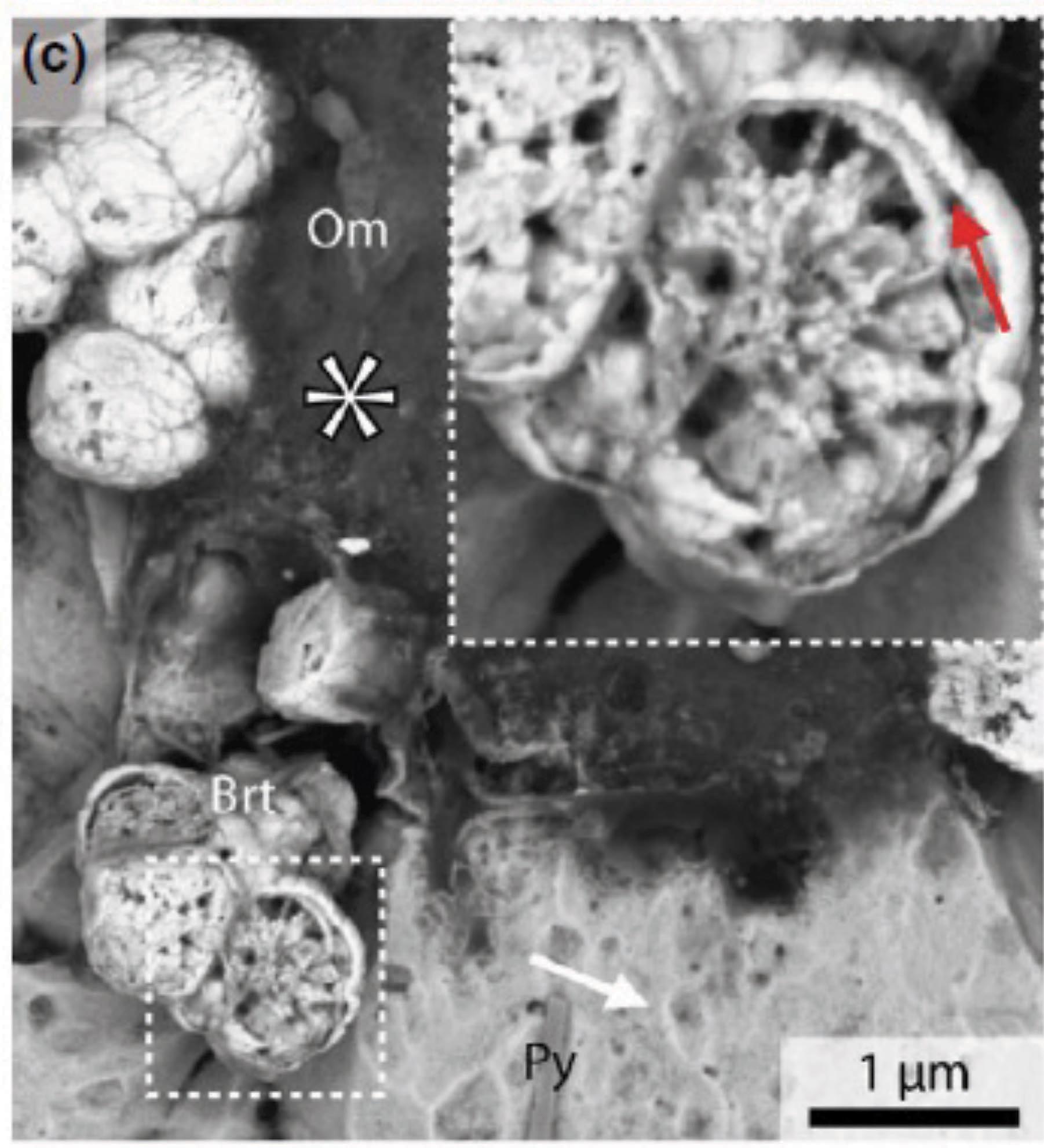
Figure 2. Assemblage of micro-spherulitic barite and organic matter. The white arrow indicates nano-porous pyrite enriched in organic matter. The arrow in the inset indicates the outer shell of a barite micro-spherulite. The asterisk indicates the location of Raman Spectroscopy analysis of organic matter (see paper for more informaiton). From Baumgartner et al. (2020b).
WORKPLAN 2021
Work in 2021 will be carried out within the framework of a number of ongoing PhD projects, and post-doctoral research programs mainly funded by ARC. Dr Stefano Caruso will complete his study of the Dresser hydrothermal alteration, and Brendan Nomchong will submit his PhD on the petrography and environmental setting of the Turee Creek microbialite reef complex. Prof Van Kranendonk will continue his work on the Dresser Formation and begin his collaboration with Prof Tony Kemp (UWA) on the environmental conditions of early Earth from isotope tracers. Additional fieldwork will be undertaken at the Dresser Formation (Covid-willing), with a particular focus this time on conservation of the ancient stromatolite sites.
The third issue on hot spring research will be published in the Journal of Astrobiology (V. 21, No. 1), which includes three papers from the van Kranendonk research group.
Published outputs for 2020
CCFS publications: #1415, 1431, 1487, 1517, 1591, 1649, 1651
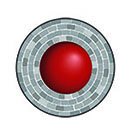
5. AUSTRALIA’S PROTEROZOIC RECORD IN A GLOBAL CONTEXT
Themes 2 and 3, Earth’s Evolution and Earth Today, contributing to understanding Earth’s Architecture.
AIMS
Earth’s history is considered to have been dominated by cycles of supercontinent formation and breakup. This program tests this hypothesis and its relevance to Australia’s geological evolution, assessing Australia’s positions during the supercontinent cycles by examining the paleomagnetic, petrological and detrital provenance record of the Australian and adjacent continents.
By studying primarily Australian rocks and comparing the results with global analogues, we aim to extend our knowledge about supercontinent cycles and the evolution of the Australian continent to the Paleoproterozoic or even further back in time. Such knowledge is fundamental for understanding the first-order fluid cycles that controlled the formation and redistribution of Earth resources, and the establishment of a 4D global geodynamic model covered in other Flagship Programs.
2020 REPORT
Numerous new findings, supported by Li’s ARC Laureate Fellow project, were published in 2020. Work continued on the paleogeographic evolution of Australia in the Precambrian during 2020 utilising palaeomagnetism and geological evidence (including detrital zircon geochronology). The new palaeomagnetic poles from the 2.62 Ga and 1.39 Ga mafic dyke swarms of the Yilgarn Craton, a significant portion of Yebo Liu’s PhD work was published. Palaeomagnetic results obtained from northern WA and the North Australian Craton were published to elucidate the Paleoproterozoic assembly of proto-Australia. An additional publication describing a modified SWEAT configuration of Australia and Laurentia during Nuna is also forthcoming. New global paleogeographic reconstructions that stretch into the Paleoproterozoic were continually reported and published throughout 2020 (see CCFS publications below). This project ended in 2020.Published outputs for 2020
CCFS publications: #1424, 1476, 1490, 1511, 1524, 1526, 1529, 1537, 1538, 1546, 1573, 1574, 1575, 1577, 1583, 1584, 1585, 1593, 1594, 1595, 1596, 1597, 1598, 1600, 1601, 1602, 1603, 1604, 1605, 1606, 1607, 1609, 1610, 1611

6. FLUID REGIMES AND THE COMPOSITION OF EARLY EARTH
Themes 1 and 3, Early Earth and Earth Today, contributing to understanding Earth’s Architecture and Fluid Fluxes.
AIMS
Zircon crystals are currently the only material that records events in the first 500 million years of Earth’s history, since no rocks have survived from this period and no other minerals have been established as Hadean in age. There is growing evidence from the study of these zircon crystals that the Earth stabilised rapidly after accretion and that both solid rock and liquid water were present within 150 million years of its formation. This program uses the geochemical signatures of zircon crystals from all known Hadean and early Archean localities, together with geochemistry of the oldest known rocks and the application of geophysical and geochemical modelling, to establish how the first crust formed, why it was destroyed and the role fluids played in this process. The changes that took place throughout the Archean are being evaluated as crustal processes evolved and plate tectonics became the dominant regime. A key component is determining the interaction between the mantle and the evolving crust. In addition, work undertaken on Martian meteorites and lunar samples is providing further constraints on the early history of the Solar System, especially the role played by fluids.
2020 REPORT
Work in 2020 was severely disrupted by COVID-19. This impacted in several ways. It meant the cancellation of fieldwork in the Windmill Hills, Antarctica, and fieldwork in both Greenland and Labrador was likewise cancelled. It also caused a delay in commencing an Australian Antarctic Division research project on legacy samples stored with Geoscience Australia due to interstate border restrictions, as well as an ARC grant to utilise Sr and Ca systematics of ancient crustal rocks and minerals to constrain the evolution of the Earth’s primordial mantle and oceans.

Synthesis of published ages from across the Napier Complex, Antarctica. Adapted from Krol et al. Goldschmidt 2020.
However, not all was doom and gloom! Sufficient samples were available from previous work on Antarctica, Labrador, Greenland and Jack Hills for some work to continue. Unfortunately, closure of laboratories for several months at partner institutions in Europe further delayed progress on these projects.
New work was mainly focused on the ancient rocks in the Ukrainian Shield with Curtin post-doctoral fellow Dr Leonid Shumlyanskyy. This led to several local geology papers and abstracts published in Ukrainian journals and a submission to Precambrian Research (now accepted) on the Eoarchean rocks of the Dniester-Bouh Domain of the Ukrainian Shield. Here, enderbites and mafic granulites formed at 3.79 Ga and at 3.5 Ga, but were affected by a range of subsequent metamorphic events between 3.0 and 2.7 Ga.
Further investigation of the Hadean and Eoarchean zircons from Jack Hills resulted in the publication of a trace element study of a suite of zircons ranging in age from 3.3 to 4.3 Ga undertaken with Prof Simon Turner at Macquarie University and published in Nature Communications. The key finding was that there was no variation in trace element systematics across the Hadean/Archean boundary at 4.0 Ga, with modelling suggesting the protolith of these zircons was consistent with andesite formed in modern subduction settings; implying an early onset of plate tectonics on Earth. In addition, lead nanospheres were identified in several new localities around the world, in association with former CCFS Marie Curie fellow Monika Kusiak from Poland and Dr Richard Wirth from Potsdam, Germany and the results have been written up for publication.
Further investigations on the 3.72 Ga gneisses in the Tarim Craton with former CCFS post-doctoral fellow, Associate Professor Rongfeng Ge from Nanjing University, led to the identification that they have decoupled, but weakly sub-chondritic, Nd and Hf isotopes, similar to ancient gneisses from Greenland. They were also affected by metamorphic events at 3.56 and 2.0 Ga. The paper was published in Earth and Planetary Science Letters in early 2020. A new study of gneisses in the southwest Tarim Craton has identified Mesoarchean rocks as old as 3.2 Ga, and further work is in progress.
The Lu-Hf investigation of ancient zircon crystals from Aker Peaks in Kemp Land, Antarctica, has now been completed and the paper prepared for publication. Also in Antarctica, new data from the eastern Tula Mountains in the Napier Complex, collected by Piotr Krol (PhD student of Monika Kusiak), revealed ancient TTG gneiss protoliths with ages of 3.75-3.56, associated with granitic gneisses 2.9-2.8 Ga in age. Geochemical data indicate gneisses of both age groups provide evidence of both medium/high-pressure and low-pressure melting; the results were published in Gondwana Research
Two studies of the Dharwar Craton in India were published in 2020. Evidence for multi-stage crustal growth in the Archean of the Eastern Dharwar Craton was revealed by a comprehensive field, petrological, geochemical and isotopic study, with four episodes of magmatism identified between 3.36-3.20 Ga and 2.57-2.52 Ga; the latter identical to the main Neoarchean magmatism in the North China Craton. This work was published by Jayananda et al. in Gondwana Research. A detailed study of the late Archean Dharwar Supergroup by Krapež et al. in Earth-Science Reviews established a rift stage from 2.77-2.72 Ga and the development of a two-stage back-arc basin sequence from 2.61-2.58 Ga and 2.58-2.54 Ga, respectively.
Lunar work in 2020 was focused on re-investigating the nature of the rocks at the Apollo landing sites. This included examining shocked zircon in the lunar highlands, obtained from clasts at the Apollo 16 site. Work also continued on investigating lunar meteorites, with special emphasis on their Pb systematics. Work on Martian meteorites included the oxygen analysis of phosphates by SIMS and also the implication of Pb isotopic data to understanding the Martian mantle. A specific investigation of 4.2 Ga Martian zircon was also undertaken, and the results applied to understanding the nature of the internal structure and geodynamics of Mars; this study was published in the Proceeding of the National Academy of the United States of America.
WORKPLAN 2021
This will in part depend on the lifting of COVID-19 restrictions and the ability to undertake international travel.
Work in Australia will remain focused on zircon from Jack Hills, especially the Hadean population. This will include a Zr isotope study in association with Simon Turner at Macquarie.
An atom probe investigation of lead (Pb) nanospheres in ancient zircons from the Napier Complex, Antarctica, will continue in order to precisely determine their distribution and isotopic composition. The full extent of Eoarchean rocks across the Napier Complex will be investigated using both the legacy collection at Geoscience Australia and samples housed at the University of Tasmania.
Work will continue on samples collected from Isua, West Greenland, in 2019, and on samples collected from Labrador in 2017. Work on the Eoarchean-Mesoarchean rocks of the Tarim Craton in China will likewise continue.
An investigation of the Eoarchean and Hadean zircons in the Singhbhum Craton in India will continue in association with Dr Rajat Mazumder in Oman.
Work will continue on both lunar rocks and Martian meteorite samples with the aim of constraining the age of the oldest crust and the precise timing of events in the early solar system.
Published outputs for 2020
CCFS publications: #1538, 1618, 1619, 1620, 1623, 1624, 1626, 1627, 1628, 1629, 1630, 1631, 1632, 1634, 1635, 1636, 1637, 1638, 1640, 1643, 1644, 1645, 1647, 1650, 1651, 1625, 1639

7. PRECAMBRIAN ARCHITECTURE AND CRUSTAL EVOLUTION IN WA
Themes 1, 2 and 3, Early Earth, Earth’s Evolution and Earth Today, contributing to understanding Earth’s Architecture.
AIMS
The enormous size and limited outcrop of the Neoarchean Yilgarn Craton and the Proterozoic orogens around its margins are detrimental to a deep understanding of what controls the distribution of mineral resources and which geodynamic processes were involved in the tectonic assembly of the Australian continent. The principal aim of this program is to combine geological, geochemical and geophysical techniques to propose a 3D structural model of the lithosphere of the Yilgarn Craton and its margins. This aim is predominantly addressed through passive source seismic experiments and integrated analysis of Hf-isotope data.
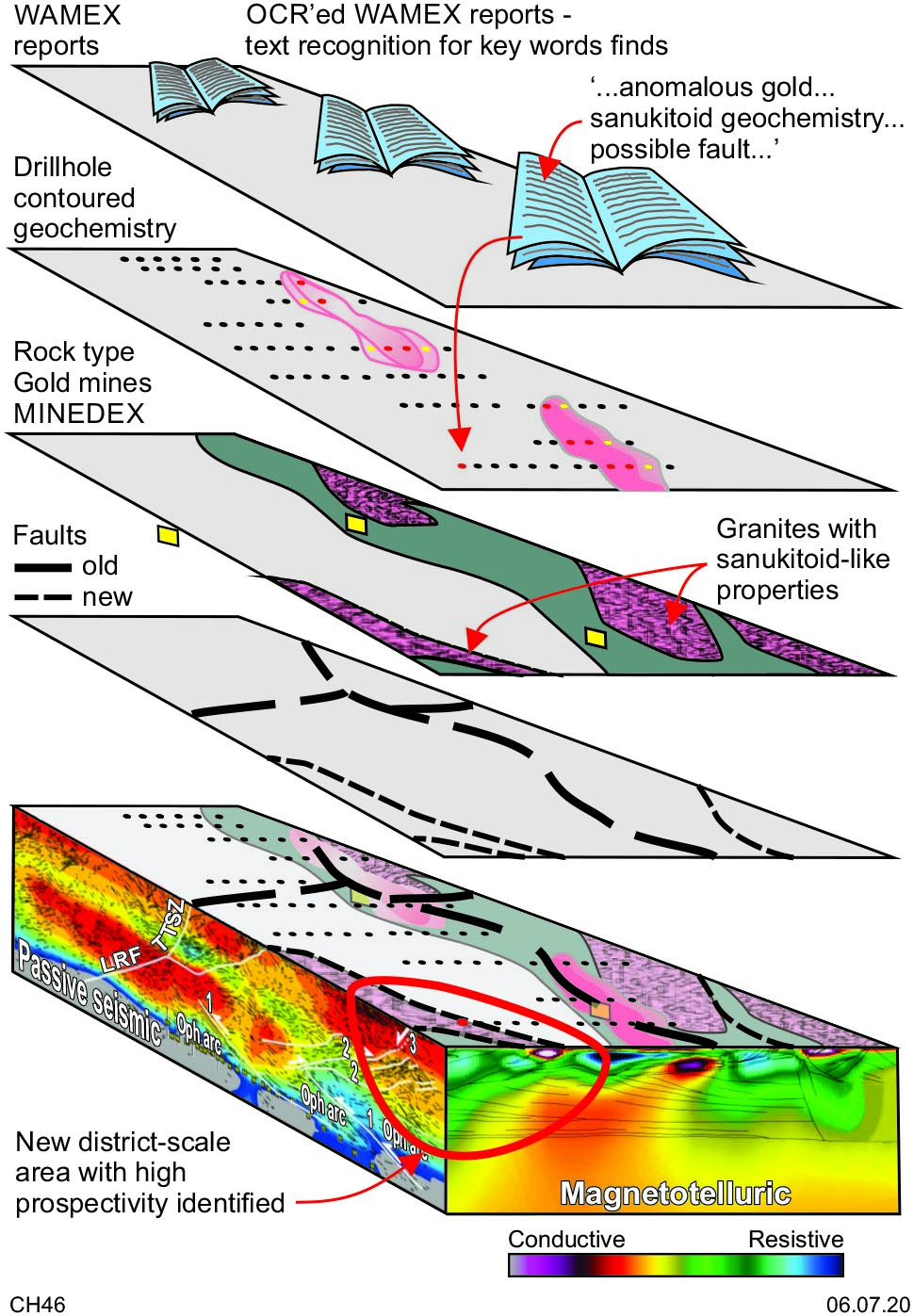
Schematic representation of integrated datasets for the Southwest and Far-East Yilgarn Craton regions.
2020 REPORT/WORKPLAN 2021
As a response to the COVID-19 pandemic and as part of the West Australian Government economic recovery plan, the Geological Survey of Western Australia (GSWA) reprioritised its 2020-21 work program. The focus shifted from fieldwork intensive acquisition of new data to delivering new interpretive datasets in key regions of the State to accelerate understanding of the region‘s geology and mineral prospectivity. These regions include the Southwest and Far-Eastern Yilgarn Craton, for which a large number of new digital layer and related products are planned to be released in the second half of 2021.
Prior to COVID-19 travel restrictions, Klaus Gessner attended the annual meeting of the Prospector & Developers Association of Canada (PDAC) and visited the Geological Survey of Canada (GSC), with which GSWA is collaborating on an international innovative 3-D geological modelling and data integration project. Klaus delivered an invited scientific paper at PDAC featuring the geology and critical mineral resources of Western Australia and presented a paper as part of the GSC Logan Club Lecture Series on the tectonic evolution of the Yilgarn Craton.
Published outputs for 2020
CCFS publications: #1434, 1579, 1580, 1581
WHOLE OF CENTRE TECHNOLOGY DEVELOPMENT

1. CAMECA ION MICROPROBE DEVELOPMENT: MAXIMISING QUALITY AND EFFICIENCY OF CCFS ACTIVITIES WITHIN THE UWA ION PROBE FACILITY
Themes 1, 2 and 3, Early Earth, Earth’s Evolution and Earth Today, contributing to understanding Earth’s Architecture and Fluid Fluxes.
AIMS
The Ion Probe Facility within the CMCA at UWA is one of the best-equipped Secondary Ion Mass Spectrometry (SIMS) labs in the world. It houses a CAMECA IMS 1280 large-radius ion microprobe, for the high-precision analysis of stable isotopes in minerals, and two CAMECA NanoSIMS 50s for imaging mass spectrometry at the sub-micron scale. This program provides a dedicated Research Associate to facilitate CCFS activities and lead the development of standards and analytical protocols at the CMCA. This greatly benefits CCFS by increasing the capacity of the Facility, enabling a higher degree of interaction and participation on research projects, facilitating standards and protocols development, and allowing greater synergy with other CCFS node facilities.

2. FRONTIERS IN INTEGRATED LASER-SAMPLED TRACE ELEMENT AND ISOTOPIC GEOANALYSIS
Themes 1, 2 and 3, Early Earth, Earth’s Evolution and Earth Today, contributing to understanding Earth’s Architecture and Fluid Fluxes.
AIMS
The overall aim is to develop new analytical methods for in situ measurement of trace elements and isotope ratios to support and enable CCFS research programs and to provide new directions of research. Specific objectives include:
• Implementation of a new Pb isotope column chemistry protocol
• Laser Ablation Trace Element Imaging with Aerosol Rapid Introduction System (ARIS) and (Teledyne CETAC Excite 193nm laser with ARIS and HDIP +)
• Ultra trace elements by LA-H-ICPMS
• In situ Rb-Sr geochronology, analytical technique and application field
• In situ Rb-Sr in Glauconite, dating and fingerprinting sediment diagenesis
• Pushing in situ Rb-Sr geochronology: going younger than 20 Ma. (Teledyne CETAC G2 193nm laser - Agilent 8900QQQ ICP-MS/MS)
• Characterisation and development of reference materials for in situ Rb-Sr dating using tandem LA-ICP-MS (Teledyne CETAC G2 193nm laser + Agilent 8900QQQ ICP-MS/MS)
• In situ Halogens quantification by tandem ICP-MS
• In situ sulfur isotope determination in sulfides using tandem LA-ICP-MS
• In situ low level chalcogenids tandem ICP-MS
• In situ split-stream measurement of trace elements and Re-Os isotopes in sulfides using LA-MC-ICPMS and Daly detectors (Teledyne CETAC G2 193nm laser + Nu Instrument Plasma II MC-ICP-MS)
• In situ strontium isotopes in phosphate/carbonate/silicate by LA-fs-MC-ICPMS (Teledyne CETAC femtosecond 198nm laser + Nu Instrument Plasma II MC-ICP-MS)
• In situ Zirconium Isotopes

 ARC Centre of Excellence for Core to Crust Fluid Systems
ARC Centre of Excellence for Core to Crust Fluid Systems